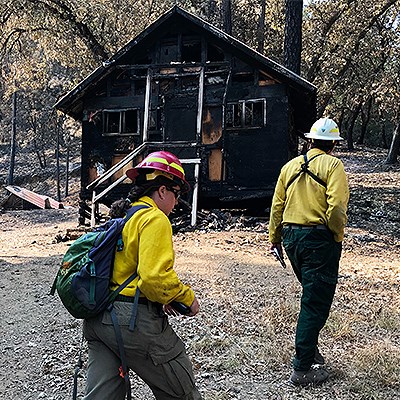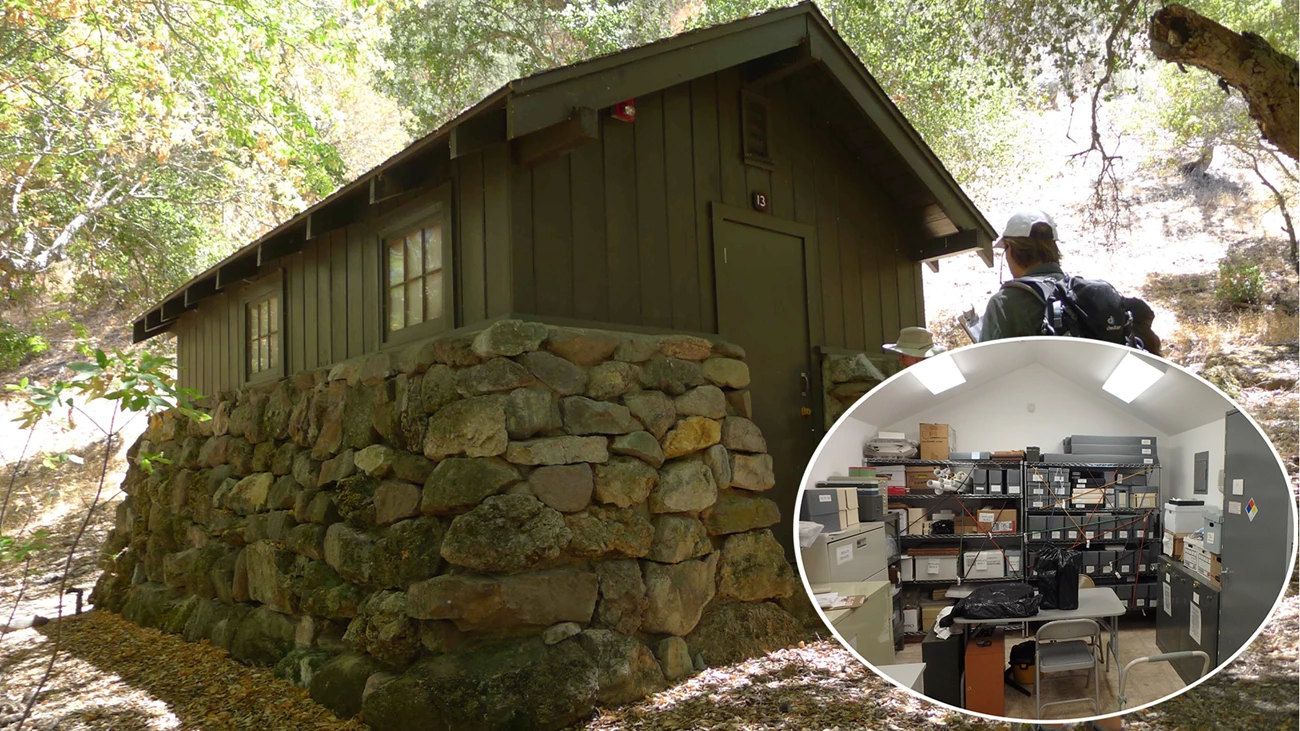Last updated: July 8, 2024
Article
Safeguarding National Heritage in the Face of Climate Change at Pinnacles National Park
Written by Anna Christie, historian
“Accept the challenges, identify the opportunities, and protect what is unique about the park.” These are the three things Blanca Stransky sees as her role as Superintendent of Pinnacles National Park. With so many competing priorities, a clear vision is essential to good leadership.
Pinnacles National Park was first preserved as a national monument in 1908 to protect its towering rock spires and rare talus caves. Over 100 years later in 2013, it became a national park. The park sits on the edge of intersecting ecosystems, which means that it is home to a diverse array of plants and animals, especially birds, reptiles, and bees. In fact, Pinnacles has over 400 species of bees, including 35 rare, threatened, and engendered species.1 Pinnacles is also one of five release sites for the endangered California condor. Sitting just 80 miles south of the San Francisco Bay Area, its 16,048 acres of wilderness beckon campers, hikers, and rock climbers.
Opportunities abound at this park, but the challenges do, too. “We might have a small park budget, but we have big park problems,” says Blanca through a crackling telephone line. Blanca was awarded a Regional Cultural Resource Award for skillfully integrating cultural resource concerns into the broader planning efforts at the park. In 2023, she led a whole-park effort to address safety concerns in Bear Gulch, where park housing, offices, and the museum collection are threatened by wildfire.
“Accept the challenges, identify the opportunities, and protect what is unique about the park.” These are the three things Blanca Stransky sees as her role as Superintendent of Pinnacles National Park. With so many competing priorities, a clear vision is essential to good leadership.
Pinnacles National Park was first preserved as a national monument in 1908 to protect its towering rock spires and rare talus caves. Over 100 years later in 2013, it became a national park. The park sits on the edge of intersecting ecosystems, which means that it is home to a diverse array of plants and animals, especially birds, reptiles, and bees. In fact, Pinnacles has over 400 species of bees, including 35 rare, threatened, and engendered species.1 Pinnacles is also one of five release sites for the endangered California condor. Sitting just 80 miles south of the San Francisco Bay Area, its 16,048 acres of wilderness beckon campers, hikers, and rock climbers.
Opportunities abound at this park, but the challenges do, too. “We might have a small park budget, but we have big park problems,” says Blanca through a crackling telephone line. Blanca was awarded a Regional Cultural Resource Award for skillfully integrating cultural resource concerns into the broader planning efforts at the park. In 2023, she led a whole-park effort to address safety concerns in Bear Gulch, where park housing, offices, and the museum collection are threatened by wildfire.

NPS / Victoria Stauffenberg
The Challenges
Pinnacles contain more than just natural wonders. There are roads that need to be maintained; telephone, internet and radio systems that need to be updated to ensure they are reliable for emergency communications and park operations – that was abundantly clear during the interview. Blanca had to switch from a video call to a telephone to talk. Park managers also care for the park’s plants, animals, and ecosystems. They preserve historic buildings and artifacts, operate museums, and conduct research. All this while trying to create a welcoming and safe environment for visitors. At Pinnacles, increases in visitation and the threat of wildfire add urgency to these responsibilities.Between 2015 and 2023, there have been at least nine significant fires in national parks in California.2 The 2018 Carr Fire in Whiskeytown National Recreational Area was the most destructive fire in the history of the NPS, burning 100 structures and 97% of the park and killing three firefighters and four civilians.3 That same year, Santa Monica Mountains National Recreation Area sustained significant damage from the Woolsey Fire, losing historic structures like Paramount Ranch and the Peter Strauss Ranch house. Pinnacles has hot, dry summers. Many of the park’s structures are nestled in Bear Gulch, a box canyon with a single road in and out. Preparing for a wildfire is a reality for Blanca.
The Vision
In 2023, Blanca convened a team of NPS employees from the park and throughout the Pacific West Region to tackle this issue from multiple angles. She takes a collective approach to leadership, relying on the strengths and expertise of her staff. “In order for us to preserve and protect the cultural resources in this high fire risk environment, everyone is involved. Everyone came together to make this project happen,” she explained.“A park for all people in all seasons” is Blanca’s motto for Pinnacles National Park.
Parks across the Pacific West are facing novel challenges because of climate change: storms surges and sea level rise are flooding some parks; drought and extreme temperatures are exposing archeological resources elsewhere; and of course, the loss of irreplaceable historic resources due to wildfire.4 This planning phase is essential for park managers to adapt to these changing conditions. “Planning is not sexy and it’s expensive,” Blanca admits. “You can’t hold up a 100-page report to a visitor to show them what you’ve done. But those plans are our recipes, helping us to make sure we’re making the right choices to preserve these places.” This planning process is an investment in the future of our national parks and it is superintendents like Blanca who are pushing it forward.5
Her advice to other superintendents? “Build networks of mutual support. Build reciprocal relationships that are long lasting” to help you get through these challenges.

NPS Photos/Timothy Babalis

NPS Photo
Museum Collections Move
This last year, Blanca and her team took action to protect park resources from the threat of wildfire. Following their Wildfire and Fuel Reduction Plans, Facility Manager Adam Leavy and his crew cut back vegetation in highly visited areas and around park buildings, ensuring over 100 feet of “defensible space” in the case of a fire. They fire hardened buildings, applying a resistant coating that slows the spread of flames. They cleaned and covered gutters and installed sprinkler systems, all in the heat of summer.They also made the significant step of moving their museum collection out of the park — the first move of its kind in the Pacific West Region. The park’s collection contains over 190,000 items.6 Its natural history collection includes an herbarium of preserved plants, as well as bird, animal, reptile, and insect specimens. The park also has archeological materials, historic objects connected with the Civilian Conservation Corp, and historic objects and archives related to the park’s homesteading and ranching era. All one-of-a-kind remnants of the past, irreplaceable if lost. Timothy Babalis, Cultural Resources Program Manager, loaded the collections into a moving van and relocated them to an NPS facility in Washington. It was not easy to voluntarily remove the collection from the park, Blanca explained.
The park's proactive approach, led by Blanca, serves as an example of what other parks can do to safeguard their invaluable park resources in their care.“We had to make some difficult decisions. But these are the decisions we have to make in times of climate change. We know the collections will be preserved for future generations. That’s the business we’re in.”
1 Roos A. 2018. Scope of Collections Statement, Pinnacles National Park.
2 “Interactive Wildfire History Timeline,” National Park Service, https://www.nps.gov/subjects/fire/wildfire-history-timeline.htm. These include: Rough Fire, Sequoia National Park (2015); Carr Fire, Whiskeytown National Recreation Area (2018); Woolsey Fire, Santa Monica Mountains National Recreation Area (2018); Castle Fire, Sequoia National Park (2019); Dome Fire, Mojave National Preserve (2020); KNP Complex and Windy Fires, Sequoia National Park (2021); Dixie Fire, Lassen Volcanic National Park (2021); York Fire, Mojave National Preserve (2023).
3 Ibid.
4 For specific reports on climate change information for NPS units in the Pacific West Region, see https://www.nps.gov/subjects/climatechange/pacificwestclimatescience.htm.
5 For more on NPS management in the face of climate change, see Resist-Accept-Direct Framework - Climate Change (U.S. National Park Service) (nps.gov) and Cultural Resources Adaptation - Climate Change (U.S. National Park Service) (nps.gov).
6 Roos A. 2018.
ParkPlanning - Environmental Assessment for the Fire Management Plan at Pinnacles National Monument (nps.gov).

